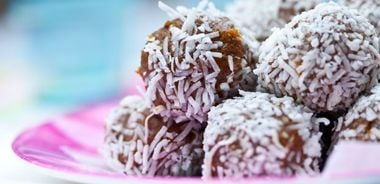Orange Coconut Fruit Balls

If you’re not a fan of packaged energy bars, these make-ahead balls of goodness will help power you down the trail.
3/4 cup (180 mL) raisins
3/4 cup (180 mL) walnuts
3/4 cup (180 mL) dried dates, pitted
3/4 cup (180 mL) dried apricots
Juice of 1/2 medium orange
Zest of 1 medium orange
1/3 cup (80 mL) unsweetened shredded coconut
At home
In food processor, pulverize raisins, walnuts, dates, and apricots for 1 to 2 minutes until finely chopped. Add orange juice and zest; blend for 1 to 2 minutes more or until mixture clumps together.
Place coconut on plate. Dampen hands with water, form mixture into 1 in (2.5 cm) balls, and roll them in coconut.
At camp
Preferably, store balls in a cooler to maintain freshness.
Makes 14 balls.
Each ball contains: 122 calories; 2 g protein; 6 g total fat (2 g sat. fat, 0 g trans fat); 19 g carbohydrates; 2 g fibre; 3 mg sodium
Source: "Get Fired Up", alive #346, August 2011





